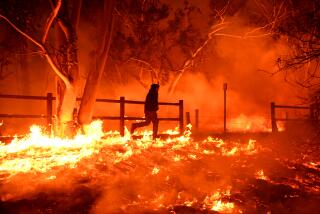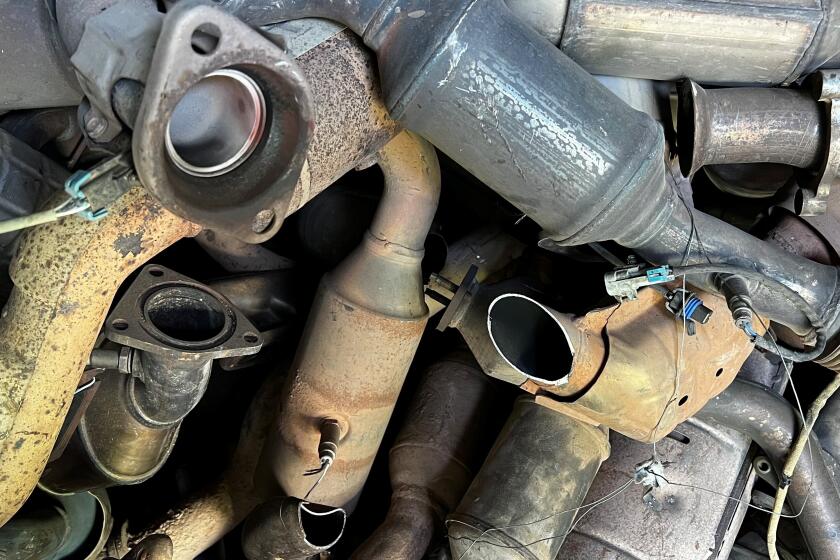Edison electric tower at center of Eaton fire investigation is dismantled and removed for testing

- Share via
An idle Southern California Edison transmission tower was dismantled, removed and flown away via helicopter Wednesday so it could be tested to determine what, if any, role it played in igniting the devastating Eaton fire.
The pylon overlooking Eaton Canyon has for months been the focus of investigators who are looking to determine what sparked the deadly fire on Jan. 7, after video captured the initial flames burning underneath the structure.
Known as M16T1, or Tower 208, the structure has not been used by the utility company for more than 50 years, but Edison officials said it, and the idle line it carried, somehow became reenergized the day the fire began to burn. In a previous interview with The Times, Edison International Chief Executive Pedro Pizarro said the reenergization of the line, through a rare phenomenon known as induction, is now a leading theory into what sparked the inferno.
On Wednesday, crews uninstalled the metal tower from a steep, now-charred hillside overlooking Eaton Canyon, where it has stood since 1971.
A sky crane helicopter lifted and transported the tower in two large pieces.
SCE had planned to remove the tower since last week, but rain and overcast skies forced crews, and the helicopter used to lift and carry the equipment off the hillside, to delay the work.
The tower was dismantled and transported via truck to a warehouse in Irwindale, where it will be examined, photographed and tested in a laboratory setting to look for clues, said David Eisenhauer, spokesperson for Southern California Edison.
In the warehouse, the tower will be tested and examined by fire investigators with Los Angeles County Fire, Southern California Edison officials and experts hired by a growing list of plaintiffs who have since sued the utility company for allegedly sparking the fire.
“We’re really looking for anything that will help in the investigation,” Eisenhauer said. “It’s a close-up examination where we look for any information.”
Three transmission towers sit near one another on the steep hillside, but only the idle tower was removed Wednesday.
Southern California Edison has announced that it will bury more than 150 miles of power lines in in Altadena and Malibu following January’s firestorms.
Two weeks ago, SCE removed the idle power lines that connected to the tower and were part of the Mesa-Sylmar SCE line, which has also been idle for decades.
Los Angeles County Fire officials are still investigating the fire’s start and have not commented on a possible cause, but private investigators and Southern California Edison officials have focused their attention on the canyon transmission towers.
The utility company has also disclosed to state regulators that it found unusual activity on its equipment at about the same time the fire was believed to have started.

The company reported to state regulators that four lines, including the dormant Mesa-Sylmar line, saw a momentary increase of electrical current at about the same time the fire began. The incident occurred after the company detected a fault on its Eagle Rock-Gould line, which connects to the Gould substation in La Cañada Flintridge, roughly five circuit miles from the suspected ignition point of the fire.
On Jan. 19, Edison crews also briefly reenergized the transmission lines over Eaton Canyon and “observed a small flash of white light upon each re-energization.” The flashes occurred on equipment that carry the Mesa-Vincent and Goodrich-Gould active lines, Edison officials said in a letter to regulators. Flashes were also seen on the Mesa-Sylmar line, which was not connected to a substation.
Some attorneys suing Edison have also alleged that the idle tower, 208, was improperly grounded and posed a risk, pointing to a grounding wire that appeared to have been exposed on the hillside. The grounding line is meant to be connected to the tower and buried deep in the ground, but photos submitted in court showed about 4 feet of the wire protruding from the steep hillside, under the tower.
Southern California Edison changed how crews ground idle transmission towers just days after the Eaton fire, but they won’t say what was changed.
Just weeks after the fire ignited, SCE updated an internal manual, detailing how crews should ground idle transmission towers — like Tower 208 — from now on. SCE officials said it was the only change made to the large, detailed manual after the Jan. 7 fire.
Edison at first declined to disclose what changes were made to the manual. A spokesperson said the changes were to clarify language in its grounding policy.

The company later shared with The Times the changes made to its idle tower grounding policies, showing the new grounding instructions provided new specifications for equipment, including the type of grounding wire and number of bolts to be used, depending on the type of structure.
The previous version of the manual did not provide that type of specificity. Rajdeep Roy, vice president of transmission operations for Edison, told The Times that, before the changes, engineers determined the grounding procedures on a case-by-case basis, taking equipment, terrain and surroundings into account.
Edison officials said a second tower, which had also been connected to the Mesa-Sylmar line, was scheduled to be removed and taken to the Irwindale warehouse later this week, so it could also be inspected and tested.
That tower, Eisenhauer said, was near the Gould substation, where the fault had been detected by the utility company.
More to Read
Sign up for Essential California
The most important California stories and recommendations in your inbox every morning.
You may occasionally receive promotional content from the Los Angeles Times.













